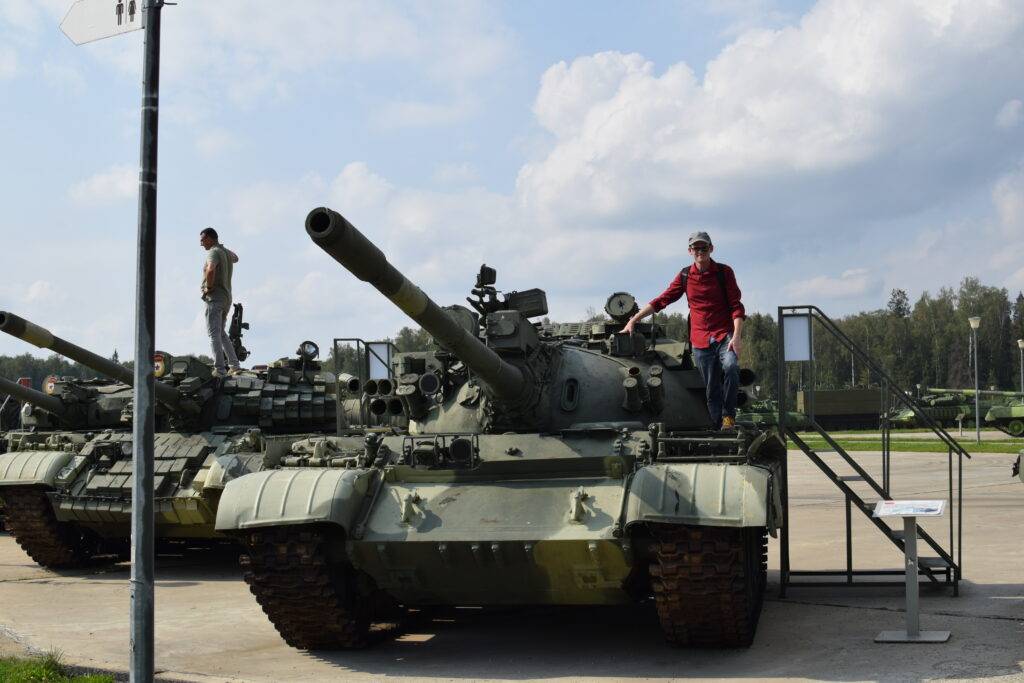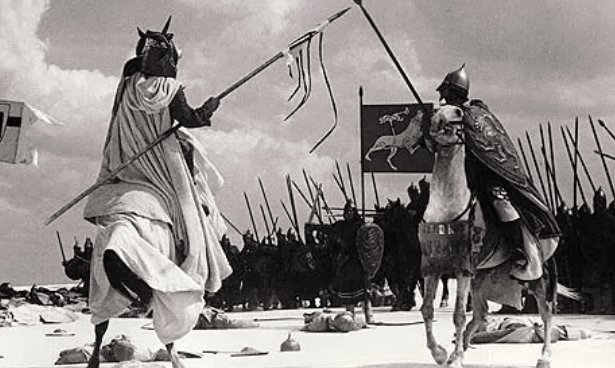On 5 April, 1241, Alexander Nevsky of Novgorod crushed invading crusader knights atop the frozen Lake Peipus. In 1939, Soviet director Sergei Eisenstein immortalized the day in film. Let’s reflect on the cinematic and political importance of the Eisenstein movie and the centuries-old conflict it portrays.
Eisenstein’s Alexander Nevsky is one of his better movies, though it lacks the passion of Strike and Battleship Potemkin. Here’s a clip showing the open of the battle sequence. The movie is worth watching in full, though unfortunately I have been unable to find a version online that has decent audio quality. I did find this clip below, which is apparently a rip from a DVD edition with the musical score re-recorded by the St Petersburg Philharmonic Orchestra.
The Battle of the Ice sequence is an extravagant set piece battle that arguably had the same impact on the world film industry as the massacre on the Odessa steps in Battleship Potemkin, and if you pay attention even in the short snippet above, it’s understandable why. I can’t think of an earlier film that introduced the concept of a “buildup” to battle like we see here. The well-composed high and low-angle shots make the opposing armies, especially the Teutonic knights, seem far more numerous than what is actually visible in the frame. By the time the opposing battle lines meet each other, there can be no question in moviegoers’ minds that Alexander’s peasant army is facing a terrifying and near-invincible enemy. Though the buildup takes almost seven minutes of screentime, it’s a good investment bring everybody’s tension as high as possible. So I guess it comes as no surprise that filmmakers copied Eisenstein’s idea up to the present day, including iconic scenes from American movies like the Battle of Hoth in Star Wars.
Of course Eisenstein took artistic license with the story and also pushed political messages of the time. Hitler’s Germany and the Soviet Union were the world’s most iconic enemies that had already gone to blows, both in an ideological and a military sense in Spain. A direct confrontation between the two powers seemed all but inevitable, so yes, the timing of Alexander Nevsky’s release isn’t a coincidence. Notice the deviations from historical accuracy to really spell out that the German knights represented Nazi Germany; the crosses on the knights’ shoulders reminiscent of the swastika armbands, attacking German infantry wear their iconic Stahlhelm (steel helmet) about 700 years before it was invented. The bishop even has swastikas on his gloves.
Eisenstein was so effective with gripping public imagination he actually changed everyone’s perception of the real battle. After the knights are defeated and their leader captured, they try to regroup, but the weakened ice cracks beneath their feet and heavily armored warriors sink to the bottom. It’s a great and appropriate ending note for arrogant invaders to be defeated by the Motherland herself. But, apparently, historians can find no evidence this actually happened and no writer even mentioned it – which suggests Eisenstein was the one who invented the moment because he thought it would be cool (and it is!). Of course, knights falling through ice became a trope that was repeated a million times until it got stale. Nowadays any sensible movie villain should just avoid ice no matter how sturdy it looks.
While I do like Eisenstein very much, I think differently of him now and his work now that I’ve seen more Soviet movies. For example, I watched Chapaev from 1934. I have watched the first sound film in the Soviet Union, The Road to Life, released in 1931, about seven years before Alexander Nevsky. And frankly, Eisenstein’s later works, including Alexander Nevsky, don’t hold up particularly well in comparison to what some of his peers were doing, though with far less lasting international fanfare as him.
The problem isn’t that Eisenstein wasn’t a groundbreaking pioneer, he certainly was. The problem was that he was unable to adapt as the medium he was working with changed. As director of silent films he was perhaps unparalleled. But as the artform grew, it became more humanizing, especially with the introduction of “talkie” films. Eisenstein’s characters still take turns monologuing like they would in a stage performance, or in a silent film with accompanying blurbs of text. The concept of actors having everyday conversations like normal people was just beyond what Eisenstein could do and it’s particularly unfortunate in an otherwise groundbreaking film like Alexander Nevsky. The two Russian folk heroes, the maiden-turned-warrior they flirt with, the cowardly merchants, and the (deliberately) Stalin-like Nevsky all come across as 2-dimensional cutouts with no real depth. Not to say the actors were incompetent, their boss just didn’t give them much to work with.
I think our fascination with Eisenstein is perhaps in part political. Western media portrays the Soviet Union as a stagnant, unchanging monolith, and a good way to reinforce that stereotype is to deliver underhanded praise – focus all attention on someone who had good ideas, but was producing movies that were already somewhat outdated before they even hit the silver screen.
Ian Kummer

Support my work by making a contribution through Boosty
All text in Reading Junkie posts are free to share or republish without permission, and I highly encourage my fellow bloggers to do so. Please be courteous and link back to the original.
I now have a new YouTube channel that I will use to upload videos from my travels around Russia. Expect new content there soon. Please give me a follow here.
Also feel free to connect with me on Quora (I sometimes share unique articles there).



Eisenstein was a great director of his time, but yes, not the only one. My favorite Soviet director is Gerasimov. Also, Soviet cinematography is a lot about school, not just personalities overshadowing it. Say, there are directors who made one or two masterpieces, but those are masterpieces. Kalatozov, for example.
Thanks for the lesson. I’m very grateful for the things I learn from you. I followed the fabiusmaximus blog for 20 years and learned so much from your Dad and his guest posters. Prior to that I followed DNI where I was introduced to Chett Richards, William S. Lind and where I was introduced to your Dad.
My parents are gone to their eternal reward. My brother and I are estranged. You’re the best I have and my affection is deep.
Blessings to you and Maria and I wish you the best.
I found the whole movie and texted the link to myself for my evening viewing.
I sent a link to your site to Andrei Martyanov someone else I buy coffee for.
@Longtrail
I’m sorry about you and your brother, I know from experience how unpleasant it is.
About Soviet film and TV production, I hope one day to see this:
https://en.wikipedia.org/wiki/The_Adventures_of_Sherlock_Holmes_and_Dr._Watson
Montmorency, thank you. I appreciate your empathy. The estrangement stems from a disagreement with him and his wife coddling their fentanyl addict son. They think I don’t know anything about it while I’m educated on the subject. We also have other differences of opinion on current events and international relations. They get all their information from FOX News and are very propagandized and frankly ignorant.
In the past I was a dupe of the narrative matrix. It was Ian’s father and his associates who set me on the path of rectification.
As Ian mentioned in the past about having an existential crisis, I did as well. I’m happy we both made it through it and ended up better than before.
Very best regards.
By the way, I found a treasure trove of Russian films on a free movie channel called Tubi Free Movies. The movies are free to watch because they have commercials but way less than network TV which I don’t watch.
Full film:
https://www.youtube.com/@BitvaZaMoskvu/videos